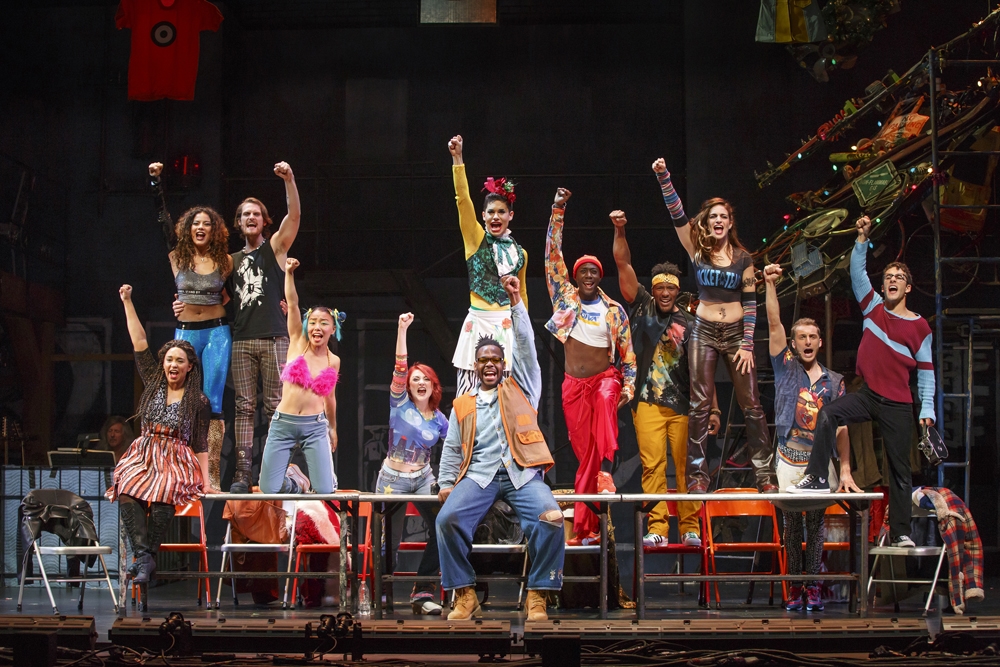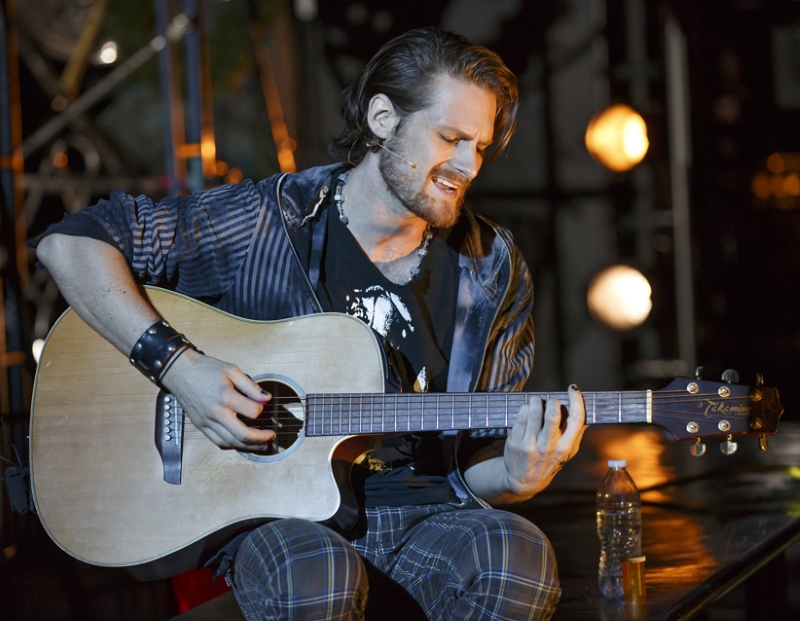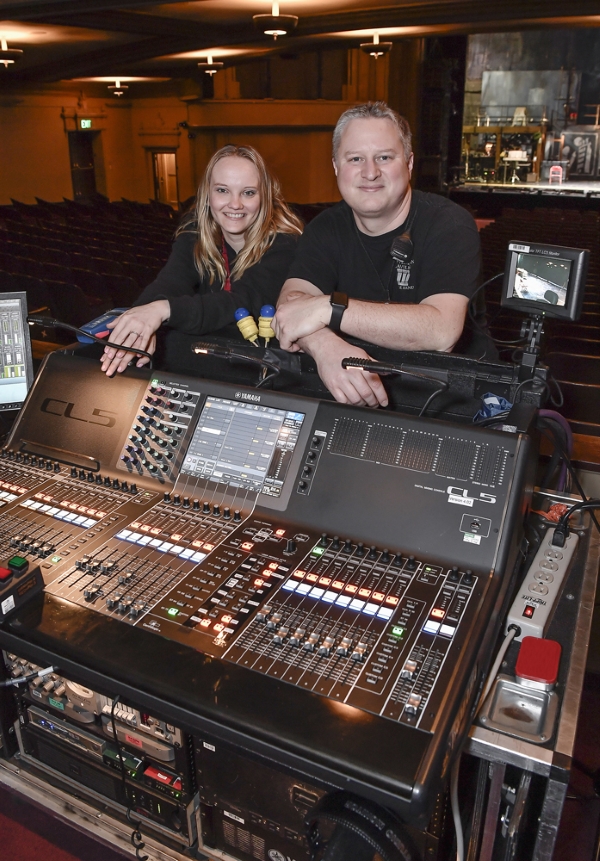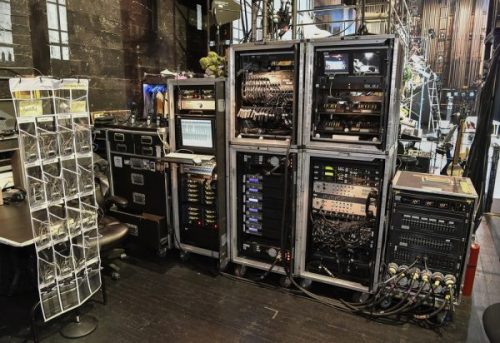First seen at the New York Theatre Workshop in 1993, the rock musical Rent has been shaped to fit the production needs of countless incarnations ranging from Off-Broadway to performances in Ireland, Sweden, Australia, and the Hollywood Bowl.
On Broadway, Rent grossed $280 million and gained critical acclaim, winning a Tony Award for Best Musical, and gaining the distinction of becoming the 11th longest-running show the Great White Way has ever seen.
Today as it celebrates its 20th anniversary, the show that Jonathan Larson based loosely on Giacomo Puccini’s opera La Boheme has lost little if any in terms of popularity and momentum.
With a touring production currently crisscrossing the U.S., it packs venues ranging in size from 1,600 to 4,000 seats, employing an audio design penned by sound designer Keith Caggiano. Taking a rock ‘n’ roll approach to the task, Caggiano built his design around a pair of L-Acoustics arrays deployed in a left-right configuration onstage.
“The sound blueprint isn’t what you would normally associate with a show like this,” notes Mike Tracey, the production’s associate sound designer. “Musicals like this traditionally take a distributed approach to audio, but we’ve obviously charted a different path, with equally obvious results. This is full-on rock, and it remains true to the sound hardcore fans both demand and expect.”

Bringing It To Life
The talent and skills of Masque Sound (East Rutherford, NJ) were enlisted to bring Caggiano’s design to life. Central to the scheme beyond the large L-Acoustics arrays found onstage is the all-digital backbone that supports the show.
Remaining entirely within the digital realm from input all the way through the loudspeakers, sound moves from the actors’ Sennheiser SK 5212-II bodypack transmitters onstage to EM 3732-II wireless receivers, and then directly into the Yamaha CL5 digital console out front with the aid of Focusrite RedNet AES devices.
A total of 30 wireless channels are used, with Masque Sound providing the initial wireless coordination for each show prior to A2 Ashley Ottensmeier’s fine-tuning efforts, which are made at each stop as needed. One of the first Broadway shows to outfit its cast with headsets as opposed to lavalier mics, Rent kept with tradition this time out, using DPA d:fine 4066 omnidirectional headsets.
“We don’t try to hide mics,” Tracey notes, “and with the DPA headsets, we can get them really close to the actors’ mouths, providing a lot of gain. A lot of shows take great effort to keep their technology hidden entirely from view. Not so here. Everything is right there for the crowd to see. That’s the look the show has always had, anything different and it wouldn’t be Rent.”
Standing upfront, the two main left-right L-Acoustics arrays house 11 Kara enclosures per side, as well as a pair of SB18 subwoofers arrayed in a cardioid configuration. Discreet coaxial 5XT loudspeakers provide front fill, while two X12 coaxials stand-in as down fill. A half-dozen LA8 amplified controllers mounted in an LA-RAK enclosure are controlled via an LA Network Manager. Two spare LA8s are also kept at hand.

Complementing the L-Acoustics components within the sonic landscape is a center array of self-powered Meyer Sound M1D loudspeakers help with imaging in theatres with balconies. The cabinets additionally keep the sound image centered in terms of the crowd’s perception, especially for those seated in seats at the outer left-right edges of the area of coverage.
Matters Of Space
Setting up for a musical is considerably more complicated than a standard rock show in that there are considerably more details to tend to, and thanks to the amounts of gear required, often with less space to do it all in.
“Available real estate is always an issue,” notes front of house engineer Mike Rukstad. “We play a lot of venues that literally have no space left backstage after we back our three trucks in and finish the load-in. Part of the challenge is carrying enough gear to make sure you can keep your sound consistent wherever you may be, in venues large or small. Paradoxically, oftentimes it comes down to having to shoehorn ourselves into a space and then deciding what we can and can’t keep to make sure the show keeps running.”
As a way to help ameliorate this spatial conundrum, the Yamaha CL5 console at FOH maintains a svelte mixing footprint while also providing the technical chops required to help bridge the divide Rent is always straddling between being a rock show and a musical.
“It’s a little funky to do some of our programming with at times,” Rukstad says, providing a running account of his experiences thus far with the desk, “but at the end of each day I have zero problems with it. Really it’s perfect for what we’re doing, which is essentially musical theatre with rock-esque moments. The volumes are here, but not always. I deal with emotion more, using my volume to create textures with a blend and balance of voices, instruments, and drums.
“The story is paramount, and that means vocals are just as imperative. Regardless of if they are a whisper or a scream, they remain on top of my mix and intelligible at all times.”

Making Scenes
The biggest difference, perhaps, between a rock show and a musical like Rent is the style of mixing employed at FOH. In musical theatre like this, line-by-line mixing is used, i.e., when an individual actor is singing or speaking, his/her mic is on and the console’s fader is up. When the actor is not producing output, the mic is off and the fader is down.
“In a traditional mixing sense employed in the not-so-distant past,” Rukstad explains, “you would be on faders all night pushing things up and down constantly. So much, in fact, that it would feel like you’re playing a piano. Thanks to today’s technology, however, we can create scenes on our consoles, and as a result, mixing in the theatre and for musicals like this has become heavily scene-based.
“I mix only on my DCAs, so every time I change a scene, my DCA lineup switches as well,” he continues. “What I’m mixing is always in front of me, and I use 10 faders. At the end of the first act while the cast is performing La Boheme, I’m working with 16 scenes. There’s no way I could do that number the old-fashioned piano-player way, flipping through endless layers. Sigital automation makes things a lot more tamable, regardless of whether I’m mixing one person or the full cast all at once.”
Processing for the show is largely derived from the CL5’s onboard Premium Rack selection of effects. Compression, EQ, reverb – for individual vocals as well as the entire 5-piece band onstage – it’s all pretty much an internal affair, this despite the considerable amounts of rack-mounted gear that visitors encounter backstage and out front at every stop along the tour.

“Yes, indeed, you see a lot of racks out here,” Rukstad says with a wave of his hand across a backstage landscape that has an almost post-apocalyptic, dystopian look like something out of the 1982 Ridley Scott film Blade Runner. “It may all seem imposing, but you have to consider that a lot of it is for com and our own video monitoring. Actually, things are a lot less complicated on this level than ever before.”
A pair of FOH computers (backup and main) can be found among the selections of outboard gear at FOH, along with two MC3000 units from TC Electronic, one of which is used for additional band reverb, and the other for vocal reverb.
A clear plastic hanging shoe organizer that’s commonly used to bring better order to bedroom closets can also be found. As a creative and resourceful means to an end, it houses all of the DPA headsets and wireless packs, providing easy access and organization.
Representing a further departure from rock show tradition, there is no designated monitor engineer on the tour. Plugged-in with their own personal earbuds, everyone in the 5-piece band uses an Aviom A16 personal mixer mounted at their fixed stage right mic stand positions. Each of the Aviom units gets its own mix directly from the FOH console.
Set up left-right as a mix, these sends are the same as used for general foldback onstage, which is divided into zones served by a collection of cabinets that includes three more Meyer Sound M1D loudspeakers. The foldback mix is essentially the house mix, only set at a constant level.
The Last Stop
Rent spent all of December last year in Tokyo, Japan. Long runs are not always the norm, however, as a spate of 28 one-nighters that followed early in 2017 demonstrates, as did the first segment of the tour’s infamous 10 cities in nine days run. A crew of 11 normally manages things, along with the help of local stagehands.

Beyond her duties wrangling RF, A2 Ottensmeier takes charge of much of the onstage setup, including the running of cables, managing of foldback elements, and interfacing with the actors in terms of miking them up and handling other people-to-people relations.
“I don’t often have to describe what it is I do,” Rukstad says on a parting note. “But ultimately if you pin me down and make me define what this all is, I’ll have to say I’m the last stop before what the actors and musicians onstage are creating goes out to the crowd. I help interpret their collective creative efforts.
“There are a lot of things to consider in terms of our sound, and it’s up to me to put the proper spin on things – a little more organ here, push those guitars out there – in order for this show to sound its best.
“I mix for what I think should be heard. It’s always dynamic, and the sound is impressionistic in the way it moves and stirs people. There’s more here than most people realize, and everything has to complement everything else.”



















